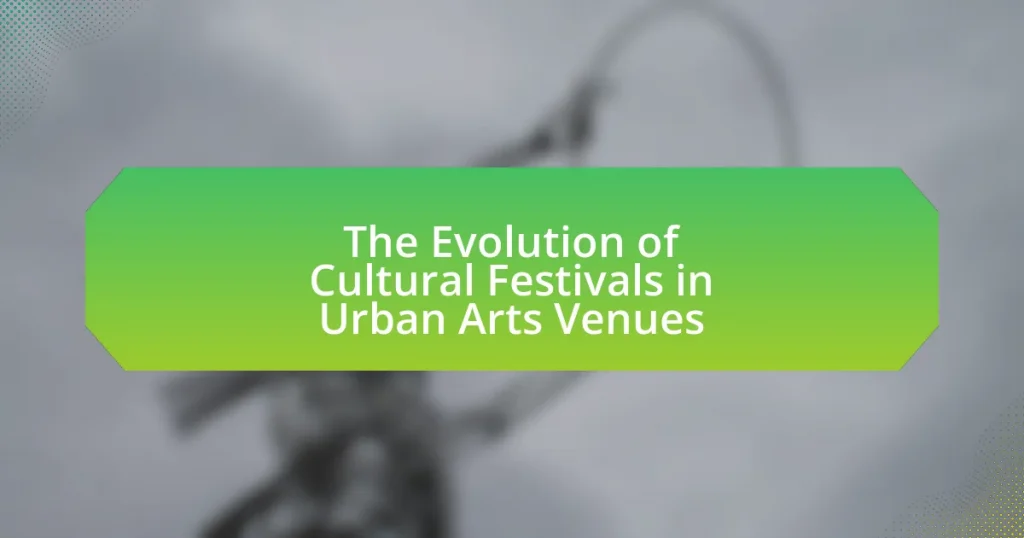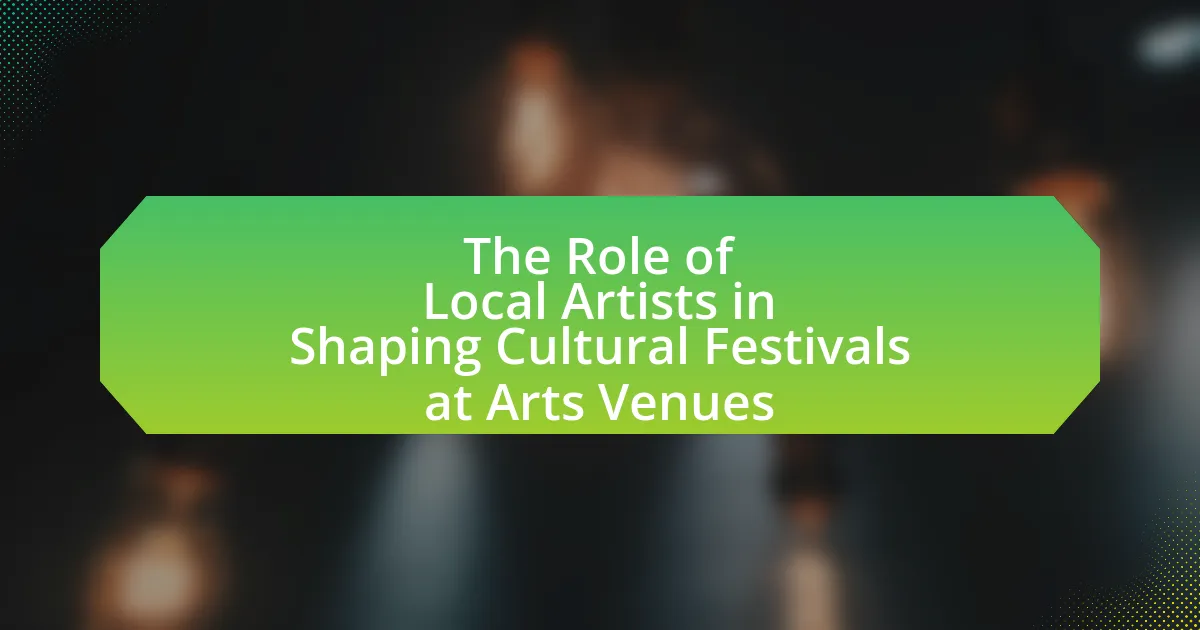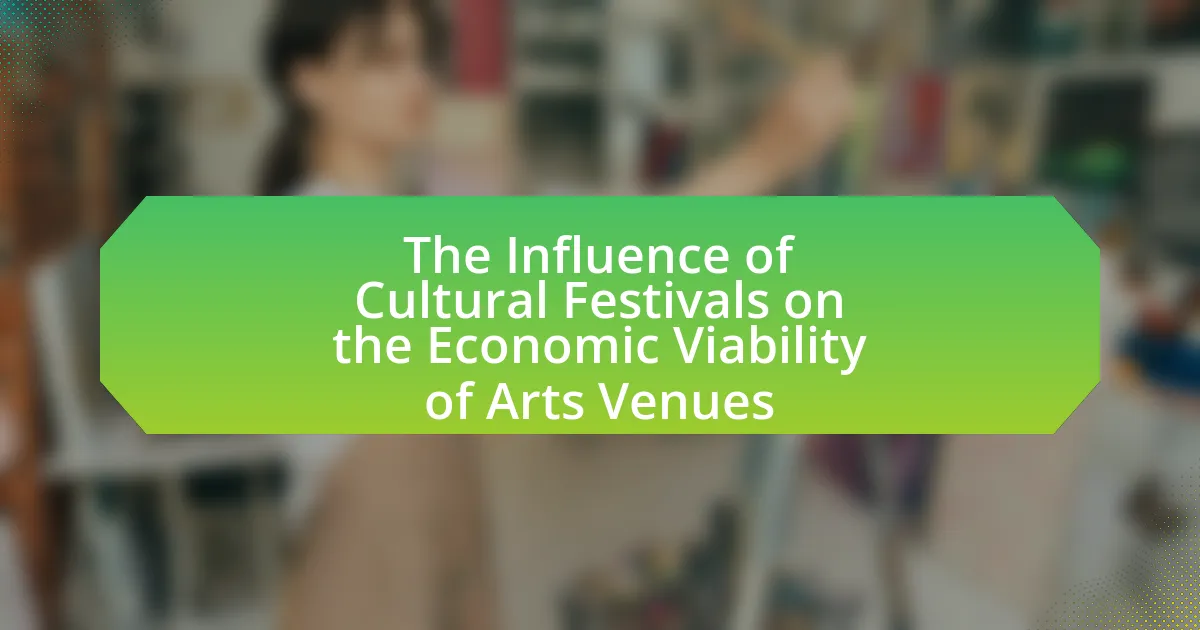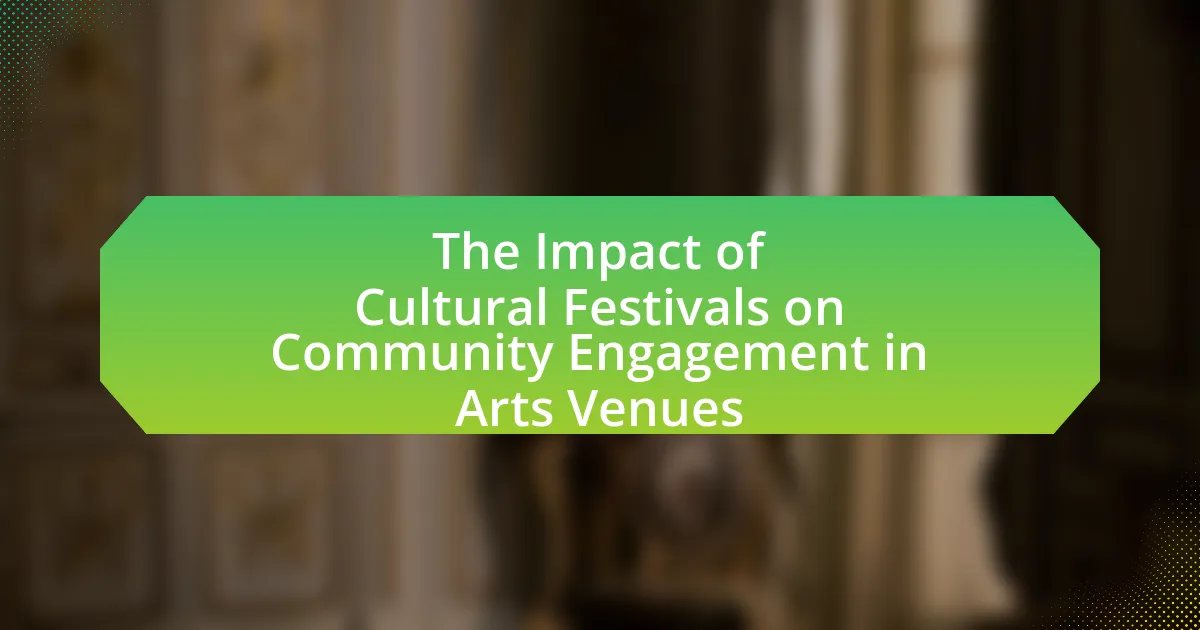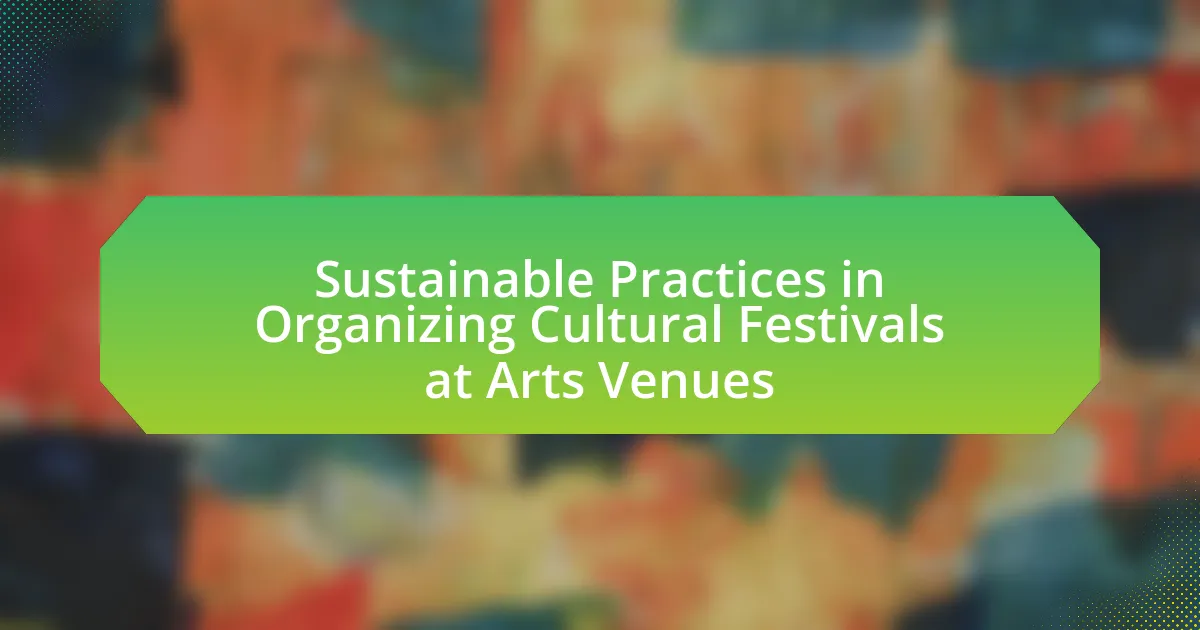Cultural festivals in urban arts venues are organized events that celebrate a variety of artistic expressions, including music, dance, visual arts, and culinary traditions, fostering community engagement and cultural exchange. The evolution of these festivals has transformed them from localized events to large-scale celebrations reflecting global influences, driven by factors such as urbanization and globalization. Key elements for successful festivals include community involvement, diverse programming, effective marketing, and logistical planning, while contemporary challenges are addressed through technology, sustainability initiatives, and inclusivity efforts. The impact of cultural festivals extends to local economies, enhancing tourism and supporting businesses, while also promoting social cohesion and cultural identity within urban communities.
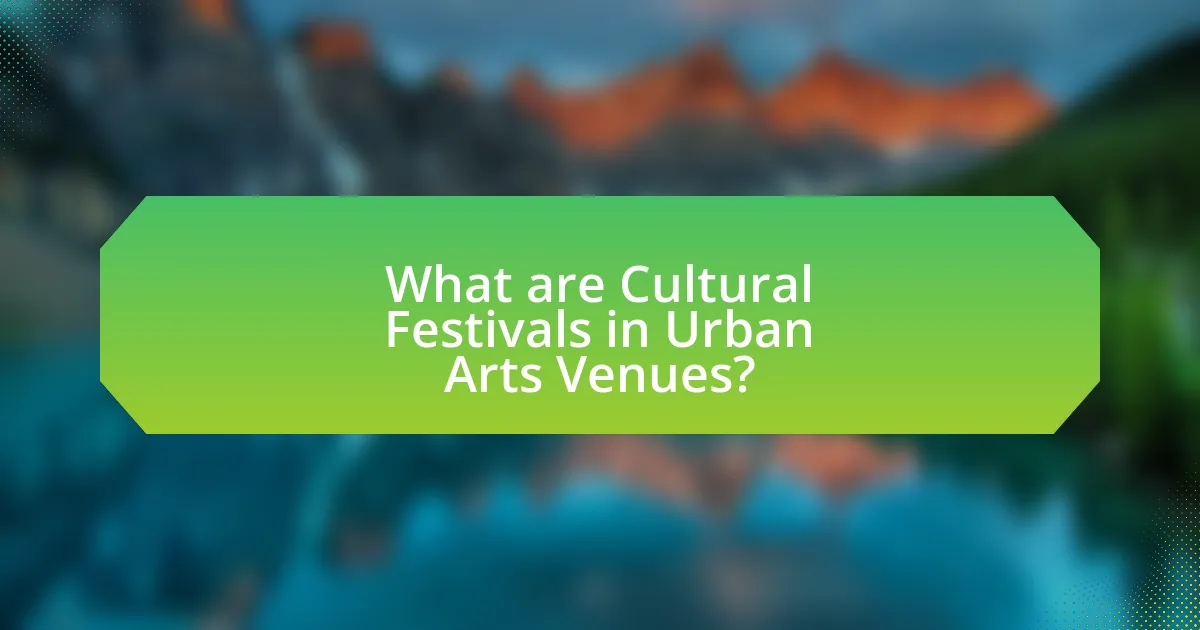
What are Cultural Festivals in Urban Arts Venues?
Cultural festivals in urban arts venues are organized events that celebrate diverse artistic expressions, including music, dance, visual arts, and culinary traditions, within city environments. These festivals often serve as platforms for local and international artists to showcase their work, fostering community engagement and cultural exchange. For instance, events like the Edinburgh Festival Fringe and the New Orleans Jazz & Heritage Festival exemplify how urban settings can enhance cultural visibility and participation, drawing significant attendance and contributing to local economies.
How have cultural festivals evolved over time in urban settings?
Cultural festivals in urban settings have evolved from localized, community-driven events to large-scale, commercially-oriented celebrations that reflect diverse global influences. Initially, these festivals served to strengthen community bonds and celebrate local traditions, often featuring traditional music, dance, and food specific to the region. Over time, particularly from the late 20th century onwards, urban cultural festivals began to incorporate a wider array of cultural expressions, influenced by globalization and migration patterns.
For instance, the rise of multiculturalism in cities has led to festivals that celebrate not just local heritage but also the cultures of immigrant communities, resulting in events like the Notting Hill Carnival in London, which showcases Caribbean culture. Additionally, the integration of technology and social media has transformed how festivals are organized and marketed, allowing for broader participation and engagement. According to a report by the National Endowment for the Arts, urban festivals now often include interactive elements and digital experiences, catering to a more diverse audience and enhancing the overall experience. This evolution reflects changing societal values and the increasing importance of inclusivity in urban cultural expressions.
What historical factors contributed to the rise of cultural festivals?
The rise of cultural festivals can be attributed to several historical factors, including the industrial revolution, urbanization, and the globalization of culture. The industrial revolution led to increased leisure time for workers, which facilitated the organization of community events and celebrations. Urbanization created densely populated areas where diverse cultural groups could showcase their traditions, fostering a sense of community and identity. Additionally, globalization allowed for the exchange of cultural practices and ideas, leading to the incorporation of various cultural elements into festivals. These factors collectively contributed to the proliferation and evolution of cultural festivals in urban settings.
How have urban arts venues adapted to changing cultural trends?
Urban arts venues have adapted to changing cultural trends by diversifying their programming and incorporating technology. For instance, many venues now host a mix of traditional art forms alongside contemporary practices, such as digital art and interactive installations, to attract a broader audience. Additionally, the integration of social media and streaming platforms has allowed these venues to reach global audiences, exemplified by events like the virtual adaptations of festivals during the COVID-19 pandemic, which saw a significant increase in online participation. This shift not only reflects the evolving preferences of audiences but also demonstrates the venues’ responsiveness to cultural shifts, ensuring relevance in a rapidly changing landscape.
What role do cultural festivals play in urban communities?
Cultural festivals play a crucial role in urban communities by fostering social cohesion and enhancing community identity. These events bring together diverse groups, allowing residents to celebrate their heritage and share cultural practices, which strengthens community bonds. For instance, a study by the National Endowment for the Arts found that participation in cultural festivals can increase social interaction and community engagement, leading to a more vibrant urban environment. Additionally, cultural festivals contribute to the local economy by attracting tourism and supporting local businesses, as evidenced by a report from the American Planning Association, which highlights that festivals can generate significant revenue for cities.
How do these festivals foster community engagement and participation?
Cultural festivals foster community engagement and participation by creating inclusive spaces for diverse groups to come together and share experiences. These festivals often feature local artists, musicians, and food vendors, which encourages residents to support their community and connect with one another. For example, studies have shown that festivals can increase social cohesion, as they provide opportunities for interaction and collaboration among attendees, leading to stronger community ties. Additionally, festivals often involve volunteer opportunities, allowing community members to actively contribute to the event’s success, further enhancing their sense of belonging and investment in the community.
What impact do cultural festivals have on local economies?
Cultural festivals significantly boost local economies by increasing tourism, generating revenue for local businesses, and creating job opportunities. For instance, a study by the National Endowment for the Arts found that festivals can attract thousands of visitors, leading to increased spending on accommodations, food, and entertainment. In cities like New Orleans, the Mardi Gras festival contributes an estimated $1 billion annually to the local economy, showcasing how such events can have a profound financial impact. Additionally, cultural festivals often require local vendors and service providers, thereby creating temporary and permanent jobs, further enhancing economic growth in the area.

What are the key elements of successful cultural festivals in urban arts venues?
Successful cultural festivals in urban arts venues hinge on several key elements: community engagement, diverse programming, effective marketing, and logistical planning. Community engagement fosters local participation and ownership, which enhances attendance and support. Diverse programming, including various art forms and cultural expressions, attracts a wider audience and enriches the festival experience. Effective marketing strategies, utilizing both digital and traditional channels, ensure that the festival reaches its target audience and generates interest. Lastly, meticulous logistical planning, encompassing venue selection, scheduling, and resource management, is crucial for smooth operations and overall success. These elements collectively contribute to the vibrancy and sustainability of cultural festivals in urban settings.
How do organizers select themes and programming for these festivals?
Organizers select themes and programming for festivals by analyzing cultural trends, audience preferences, and community values. They conduct surveys and gather feedback to understand what resonates with attendees, ensuring the programming aligns with current societal issues and artistic movements. For instance, festivals may focus on themes like sustainability or diversity, reflecting broader cultural conversations. Additionally, organizers often collaborate with local artists and cultural leaders to curate content that is relevant and engaging, thereby enhancing community involvement and support. This approach is supported by research indicating that audience engagement increases when programming reflects their interests and values, leading to higher attendance and satisfaction rates.
What factors influence the choice of artists and performers?
The choice of artists and performers is influenced by several key factors, including audience preferences, cultural relevance, and market trends. Audience preferences dictate the types of performances that attract larger crowds, as event organizers often select artists who resonate with their target demographic. Cultural relevance ensures that the chosen artists reflect the themes and values of the festival, enhancing the overall experience for attendees. Market trends, such as the popularity of specific genres or emerging artists, also play a crucial role in decision-making, as organizers aim to stay current and appealing. For instance, festivals that feature popular artists can see increased ticket sales and media attention, validating the importance of these factors in the selection process.
How do cultural festivals incorporate local traditions and diversity?
Cultural festivals incorporate local traditions and diversity by showcasing regional customs, art forms, and culinary practices that reflect the unique heritage of the community. These festivals often feature performances, workshops, and exhibitions that highlight traditional music, dance, and crafts, allowing local artists and artisans to present their work. For example, the Smithsonian Folklife Festival in Washington, D.C., emphasizes cultural exchange by inviting diverse communities to share their traditions, thus fostering understanding and appreciation among attendees. This integration of local elements not only preserves cultural identity but also promotes inclusivity, as seen in events like the Notting Hill Carnival, which celebrates Caribbean culture while engaging a multicultural audience.
What logistical considerations are involved in planning cultural festivals?
Logistical considerations in planning cultural festivals include venue selection, crowd management, transportation, and resource allocation. Venue selection must accommodate the expected audience size and provide necessary facilities, such as restrooms and accessibility options. Crowd management involves planning for safety, including emergency exits and security personnel, to ensure a smooth flow of attendees. Transportation logistics require coordination with local authorities for traffic control and parking arrangements. Resource allocation encompasses budgeting for permits, equipment rentals, and staffing, which are critical for the festival’s success. These considerations are essential for creating a safe and enjoyable experience for participants and attendees.
How do organizers manage funding and sponsorship for festivals?
Organizers manage funding and sponsorship for festivals by developing strategic partnerships with businesses and securing grants from governmental and non-governmental organizations. They often create sponsorship packages that outline benefits for sponsors, such as brand visibility and engagement opportunities, which incentivizes companies to invest. For instance, festivals may offer tiered sponsorship levels, allowing businesses to choose their level of involvement based on budget and marketing goals. Additionally, organizers may utilize crowdfunding platforms to engage the community and raise funds directly from attendees. According to a report by the National Endowment for the Arts, festivals that actively engage local businesses and communities tend to have higher funding success rates, demonstrating the effectiveness of collaborative funding strategies.
What are the challenges of venue selection and layout design?
The challenges of venue selection and layout design include logistical constraints, accessibility issues, and the need for adequate facilities. Logistical constraints arise from the requirement to accommodate the expected audience size while ensuring that the venue’s infrastructure supports the event’s technical needs, such as sound and lighting. Accessibility issues involve ensuring that the venue is reachable for all attendees, including those with disabilities, which can limit options if the venue lacks proper accommodations. Additionally, the need for adequate facilities, such as restrooms, parking, and catering services, can complicate the selection process, as venues must meet these essential requirements to provide a satisfactory experience for attendees.
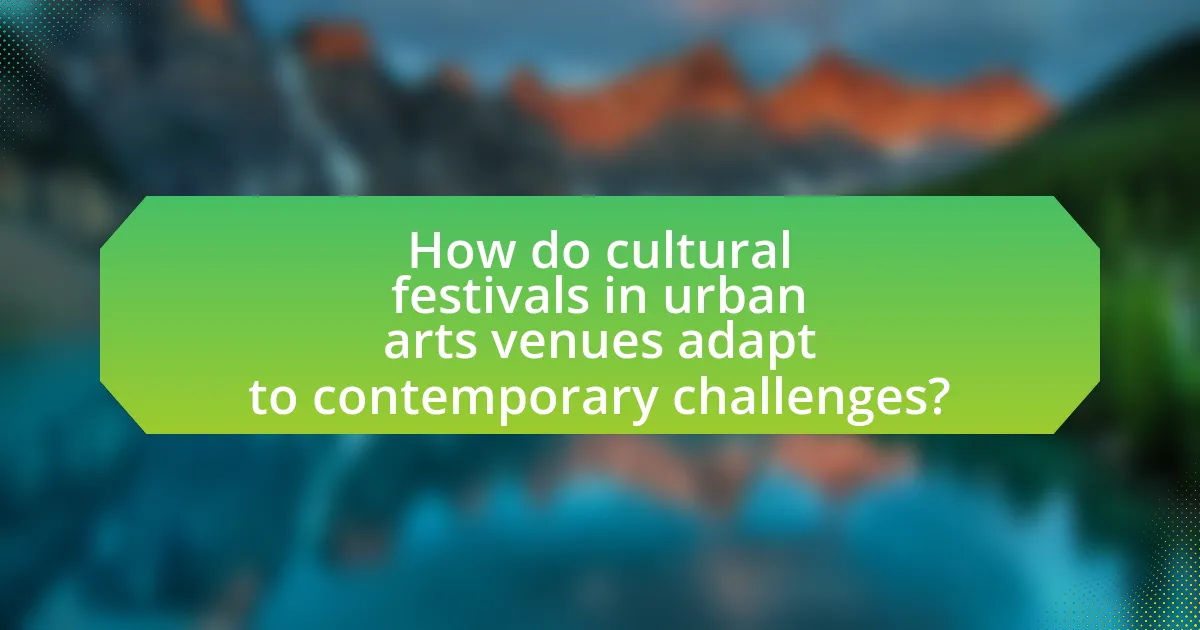
How do cultural festivals in urban arts venues adapt to contemporary challenges?
Cultural festivals in urban arts venues adapt to contemporary challenges by incorporating digital technology, enhancing accessibility, and fostering community engagement. For instance, many festivals have transitioned to hybrid models that combine in-person and virtual experiences, allowing broader participation and reaching audiences who may not be able to attend physically. Additionally, festivals are increasingly prioritizing inclusivity by offering programs that cater to diverse populations, including those with disabilities and underrepresented communities. This adaptation is evidenced by the rise in festivals implementing live-streaming options and interactive online platforms, which have been shown to increase audience engagement by up to 40% during the pandemic. Furthermore, partnerships with local organizations and businesses help festivals address economic challenges and promote local culture, ensuring sustainability and relevance in a rapidly changing urban landscape.
What role does technology play in the evolution of cultural festivals?
Technology significantly enhances the evolution of cultural festivals by facilitating broader participation and engagement. Digital platforms enable organizers to reach wider audiences through online marketing and ticket sales, while social media allows for real-time interaction and community building among attendees. For instance, the use of live streaming technology during festivals has increased accessibility for those unable to attend in person, exemplified by events like Coachella, which has streamed performances to millions globally. Additionally, advancements in event management software streamline logistics, improving the overall attendee experience. These technological integrations not only modernize the festival experience but also adapt to changing consumer behaviors, ensuring cultural festivals remain relevant in a digital age.
How are digital platforms used to enhance festival experiences?
Digital platforms enhance festival experiences by providing real-time information, interactive engagement, and personalized content. These platforms, such as mobile apps and social media, allow attendees to access schedules, maps, and artist information instantly, improving navigation and participation. For instance, a study by Eventbrite found that 70% of festival-goers prefer using mobile apps for updates and networking, demonstrating the effectiveness of digital tools in fostering community and engagement. Additionally, live streaming and virtual reality experiences enable remote participation, expanding audience reach and inclusivity.
What innovations have emerged in festival marketing and outreach?
Innovations in festival marketing and outreach include the use of data analytics, social media engagement, and immersive technologies. Data analytics allows organizers to understand audience preferences and optimize marketing strategies, leading to targeted campaigns that increase attendance. Social media platforms facilitate real-time engagement and community building, enabling festivals to reach wider audiences through user-generated content and influencer partnerships. Immersive technologies, such as augmented reality and virtual reality, enhance the attendee experience and create unique promotional opportunities, as seen in festivals like Coachella, which utilized AR to engage audiences before and during the event. These innovations collectively enhance visibility, engagement, and overall festival success.
How do cultural festivals address social and environmental issues?
Cultural festivals address social and environmental issues by promoting awareness, fostering community engagement, and encouraging sustainable practices. These events often incorporate themes that highlight social justice, environmental conservation, and cultural heritage, thereby educating attendees on these critical topics. For instance, festivals may feature workshops on recycling, local food sourcing, and cultural storytelling that emphasizes the importance of community cohesion and environmental stewardship. Research indicates that festivals can significantly enhance local economies while also serving as platforms for advocacy, as seen in events like the Earth Day Festival, which mobilizes communities around environmental action and sustainability initiatives.
What initiatives are in place to promote sustainability at festivals?
Festivals implement various initiatives to promote sustainability, including waste reduction programs, renewable energy usage, and sustainable transportation options. For instance, many festivals now utilize composting and recycling stations to minimize landfill waste, with some achieving over 90% waste diversion rates. Additionally, the integration of solar panels and wind turbines helps power festival operations, reducing reliance on fossil fuels. Furthermore, festivals often encourage attendees to use public transport, carpool, or bike to the event, which decreases carbon emissions associated with travel. These initiatives reflect a growing commitment to environmental stewardship within the festival industry.
How do festivals engage with social justice and inclusivity efforts?
Festivals engage with social justice and inclusivity efforts by actively promoting diverse representation and accessibility within their programming and operations. Many festivals implement initiatives such as community outreach programs, partnerships with marginalized groups, and inclusive hiring practices to ensure that underrepresented voices are heard and celebrated. For example, the National Black Arts Festival in Atlanta focuses on showcasing African American artists and fostering cultural dialogue, while the LGBTQ+ Pride festivals prioritize visibility and advocacy for LGBTQ+ rights. These efforts are supported by research indicating that inclusive festivals not only enhance community cohesion but also attract a broader audience, thereby increasing participation and economic impact.
What best practices can be implemented for organizing cultural festivals?
To effectively organize cultural festivals, it is essential to implement best practices such as thorough planning, community engagement, and sustainable resource management. Thorough planning involves setting clear objectives, timelines, and budgets, which ensures that all logistical aspects are addressed, as evidenced by successful festivals like the Edinburgh Festival Fringe, which attracts over 2 million attendees annually due to its meticulous organization. Community engagement fosters local participation and support, enhancing the festival’s relevance and appeal; for instance, the San Francisco Carnaval involves local artists and businesses, creating a sense of ownership among residents. Sustainable resource management, including waste reduction and eco-friendly practices, is increasingly vital, as seen in the Green Music Festival, which emphasizes environmental responsibility and has reduced waste by 50% through recycling initiatives. These practices collectively contribute to the success and sustainability of cultural festivals.
How can organizers effectively measure the success of their festivals?
Organizers can effectively measure the success of their festivals by analyzing key performance indicators (KPIs) such as attendance numbers, revenue generated, participant satisfaction, and social media engagement. Attendance numbers provide a direct measure of interest and reach, while revenue indicates financial viability. Participant satisfaction can be gauged through surveys, which often reveal insights into the audience experience, and social media engagement metrics reflect the festival’s impact and visibility in the community. For instance, a study by the National Endowment for the Arts found that festivals with higher social media engagement correlated with increased attendance and revenue, demonstrating the importance of these metrics in assessing overall success.
What strategies can enhance audience experience and satisfaction?
To enhance audience experience and satisfaction, implementing interactive engagement strategies is essential. These strategies include incorporating live polls, Q&A sessions, and hands-on workshops that allow attendees to actively participate rather than passively observe. Research indicates that events featuring interactive elements report a 30% increase in audience satisfaction compared to traditional formats, as noted in a study by the Event Marketing Institute. Additionally, providing personalized experiences, such as tailored content and targeted communication, significantly boosts engagement levels, with 80% of consumers more likely to attend events that offer personalized interactions.
